The Huntington’s blog takes you behind the scenes for a scholarly view of the collections.
Titanic Mysteries
Posted on Tue., July 5, 2022 by
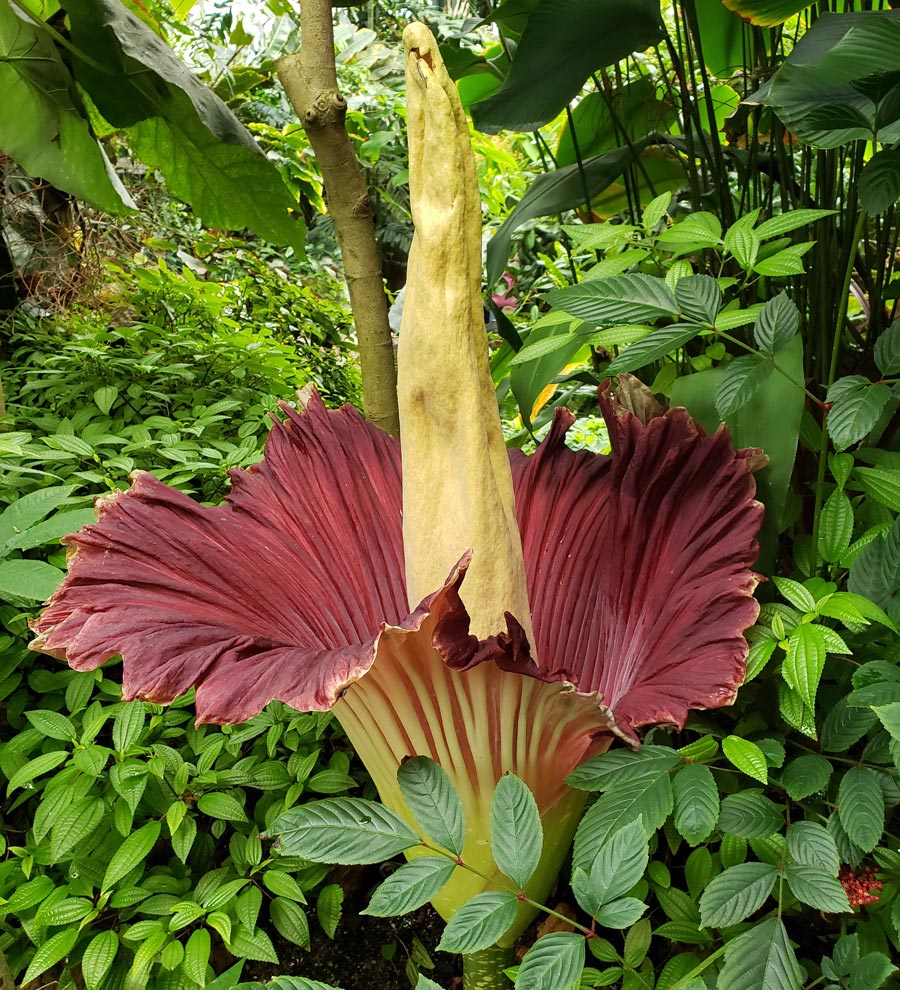
One of two Amorphophallus titanum, or Titan Arums, that bloomed in 2019. As with eminent sports and entertainment stars, the Amorphophallus titanum has inspired such nicknames as the Corpse Flower (Bunga Bangkai in Indonesian) and the Stinky Plant. Photo by Brandon Tam.
In the botanical world, the Amorphophallus titanum, or Titan Arum, has been an A-list celebrity since the first specimen in cultivation bloomed at London’s Royal Botanic Gardens, Kew, in 1889—an event that drew thousands of spectators from Britain and abroad. Indeed, growing these tropical giants has become immensely popular at many botanical gardens. The Huntington first acquired one in March 1999, and five months later, the Scott Gallery Loggia was the site of the first recorded flowering of Titan Arum in California. Since then, 21 more have bloomed at The Huntington. The most recent reached peak bloom on June 20. (You can watch a time-lapse video of the spectacle on The Huntington’s YouTube channel.) This success has afforded many opportunities for Botanical staff to contribute to scientific knowledge about the species.
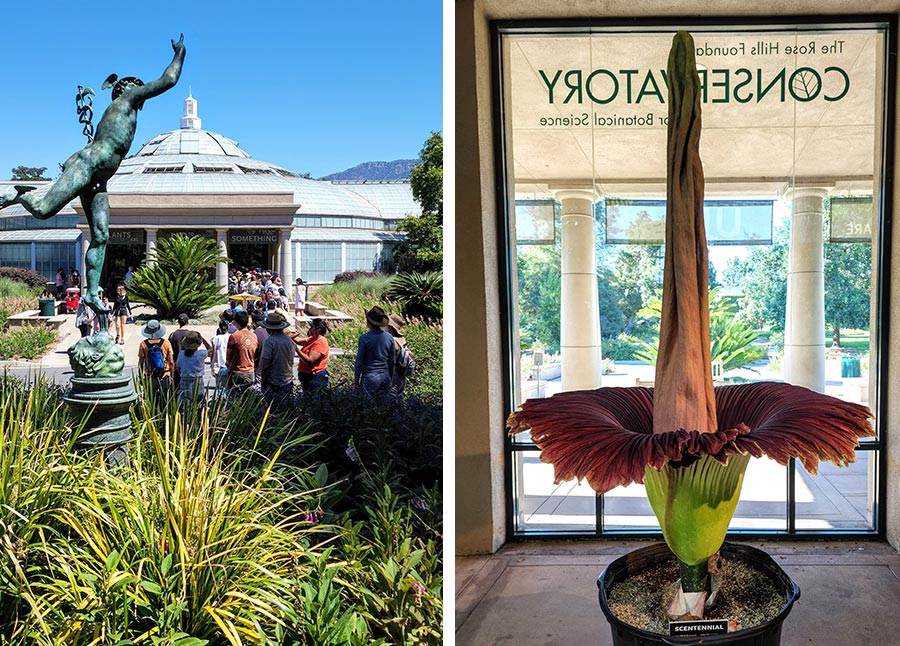
Warm spells in spring led to an early bloom this year. In June, longtime fans of the Titan Arum as well as the newly curious (left) waited patiently to see and smell Scentennial (right). Photos by Brandon Tam.
The Titan Arum’s massive, malodorous inflorescence, which can take weeks to bloom and then remains open for only a day or two, ignites all the excitement of a Hollywood premiere for fans of plant oddities. The Huntington’s first flowering drew more than 76,000 visitors and generated media attention that lasted for weeks. With the rise of the internet, the species has also become a social media darling. Last year, The Huntington boasted a record eight blooms (breaking the previous record of three in 2018) and was able to share the wealth by loaning a plant to the California Science Center, thereby introducing the species to new audiences and generating major upticks on all of The Huntington’s social media platforms.

Posts about The Huntington’s visiting Titan Arum at the California Science Center generated major upticks in the number of Huntington followers on Facebook, Instagram, and Twitter. Photo courtesy of the California Science Center.
The Dutch botanist Carl Ludwig Blume first described the genus that includes the Titan Arum in 1834. One of the largest groups in the Aroid family, it includes some 230 species. All produce flower stalks that are similar in form, many of which are also powerfully putrid. This pollination strategy attracts insects that are generally not associated with the process: flies, gnats, beetles, and others that typically feed on or deposit their eggs in decaying organic matter. When insects, attracted by the smell, explore the plant, pollen clings to their bodies and is transported by them to other plants. Species in the genera Stapelia, Aristolochia, and Ferraria, among others, also produce fetid flowers. Even a few orchid species get in on the act. But in this case, size matters. Amorphophallus titanum is the largest member of its genus and the largest unbranched inflorescence in the world. (To see super-sized branched flower stalks, visit the Desert Garden in late spring when large Agaves are likely to bloom.)
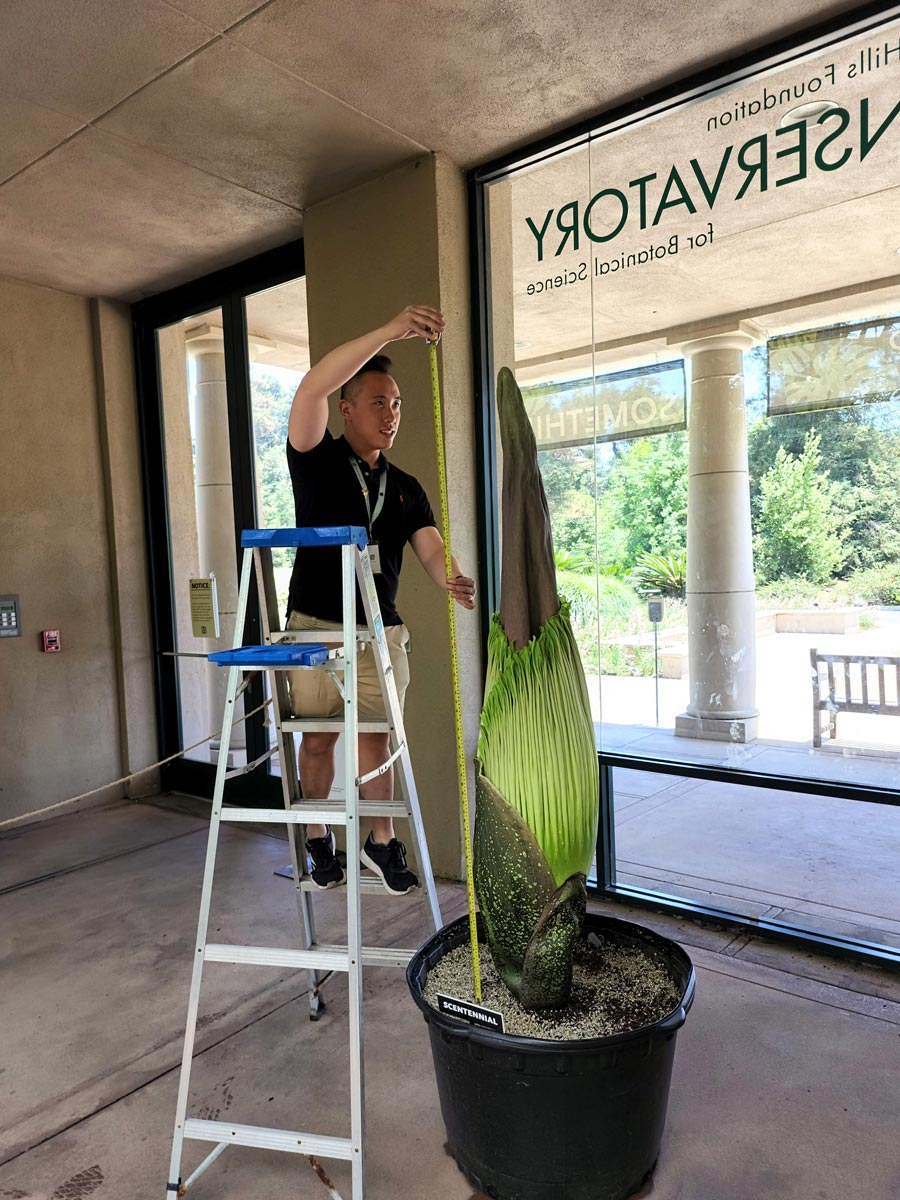
During most of the year, Brandon Tam focuses on orchids, but when the Titan Arums are in bloom, he also watches over these giants. Photo by Bryce Dunn.
Part of the Titan Arum’s appeal is its seemingly capricious nature; it’s a magnificent diva that performs only when the conditions are right. Like many plants from tropical regions, where temperatures and the amount of daylight vary little throughout the year, a Titan Arum blooms not on an annual cycle but rather when it has stored enough energy to produce an inflorescence. In some cases, an individual will produce only leaves—large and branching enough to be mistaken for a small tree—for several years between blooms.
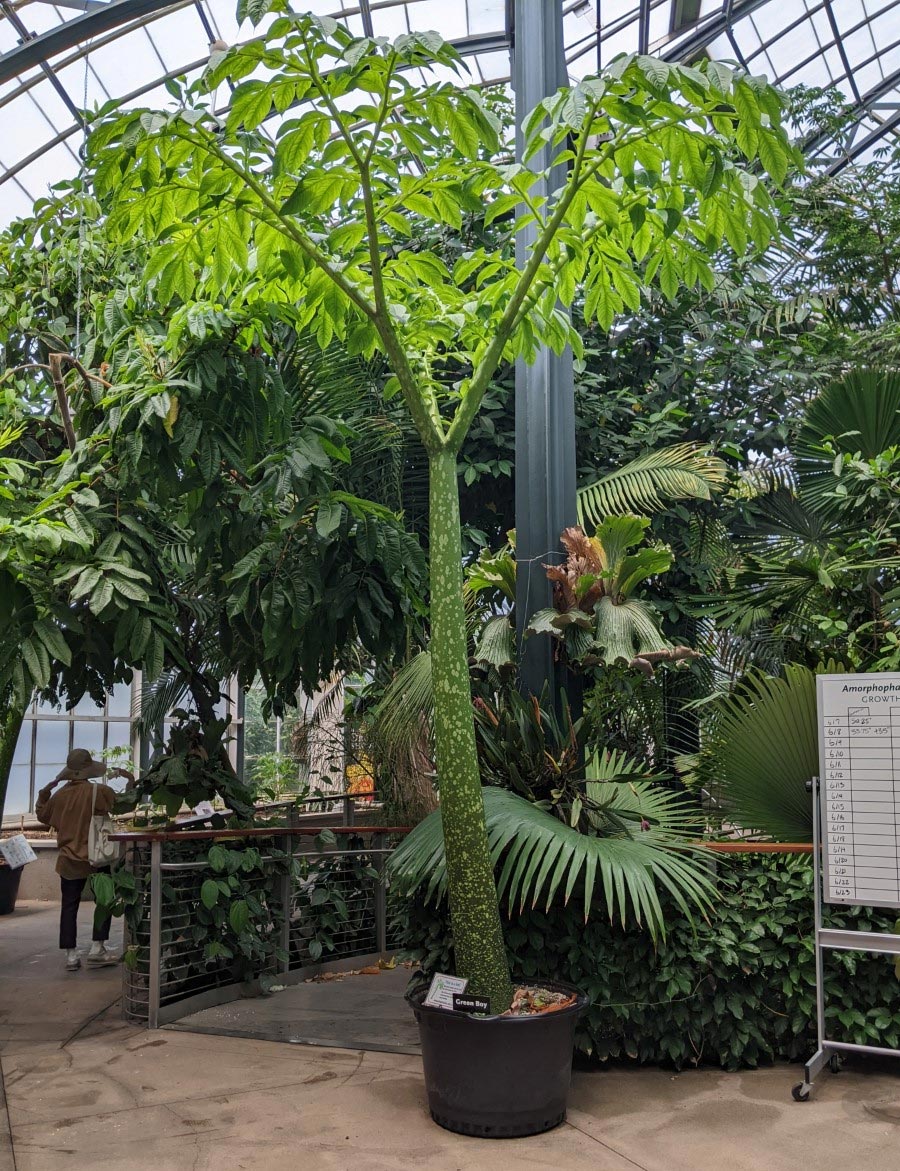
A Titan Arum (foreground) produces a single leaf at a time. The leaf can become a branching tree-like structure up to 15 feet in height. Unlike the short-lived inflorescence, the leaf lasts from 12 to 18 months. Photo by Loren Kling.
Despite the attention it draws, much of this flora fatale’s life in the wild is swathed in intrigue. Most of what is known about the species is based on plants that are living in the luxury of cultivation. In a conservatory setting, the plant is carefully tended and displayed under ideal conditions that are monitored closely. Its pollinators and seed dispersers are obvious: botanical staff. Few studies of Titan Arums in their natural habitat have been completed, so available data about the wild plants are sparse.
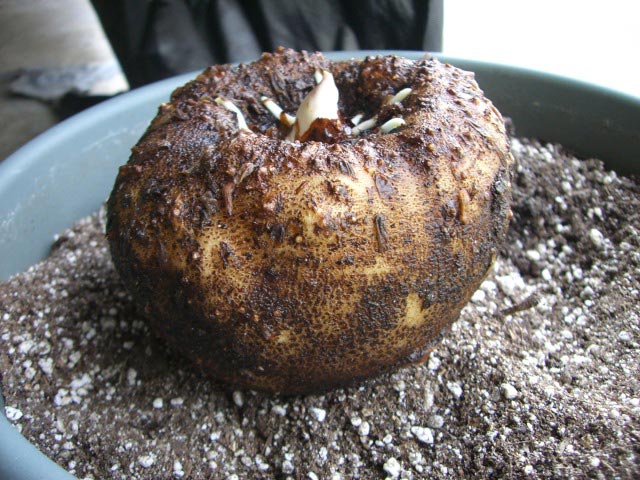
Titan Arum fruits are toxic to humans, but in Indonesia, the enormous corms, which can weigh up to 200 pounds, have been harvested as a food source. Once a corm becomes active, it takes some time to determine whether the emerging shoot is a leaf or an inflorescence. Photo by Brandon Tam.
Locating the A. titanum in its dense tropical habitat is a challenge. Because the plants grow from bulb-like structures called corms when not in leaf or in bloom, they exist in underground dormancy. Sometimes the Titan Arum’s telltale odor is the first indication that one is nearby, but that means the small window of opportunity to find and study the plant is already closing. It may have several pollinators, including beetles, flies, sweat bees, and spiders. These invertebrates have been observed visiting flowers in the wild, but the nature of their relationship to the plant is unclear. The plant may attract different pollinators over the course of a day and night, or during various stages in the development of the inflorescence. (The inflorescence is not a single flower but rather an immense stalk covered with thousands of tiny flowers—some male, some female—that bloom at different times.) Another theory suggests that pollination may be facilitated by predatory insects drawn to feed on the beetles and flies that the flowers have already attracted.

Primates and birds are among the few animal groups that can perceive the color red. Many plants rely on these animals to consume their fruits and then disperse their seeds to distant locations. Hornbills, large tropical birds of Asia and Africa that are analogous to the toucans of the Americas, are believed to be one of the dispersers of Titan Arum’s seeds. Left: Photo of Titan Arum seeds by John Trager. Right: John Gould’s illustration of a great hornbill, or Buceros cavatus, in A Century of Birds from the Himalaya Mountains, 1831. The Huntington Library, Art Museum, and Botanical Gardens.
In addition to the difficulties of studying the Titan Arum in the wild, opportunities to do so are dwindling. The species is listed as “endangered” by the International Union for Conservation of Nature, a status that is determined when a population has declined by more than 50% over the past 150 years. Fewer than 1,000 individuals may remain in the wild. The main threat to the species is habitat loss, often the result of agriculture. The Titan Arum’s native range in Indonesia is prime territory for logging and oil palm plantations. Development threatens the plants themselves, as well as the pollinators and seed dispersers that they rely on to reproduce.

Conservation is a community endeavor. Sharing propagation success means reaching more audiences. Earlier this year, The Huntington sent an Amorphophallus titanum corm to the San Antonio Zoo, where it was enthusiastically received by Horticulture Manager Gregory Works and his staff. Photo by Ariana Duffey.
The Huntington continues to support conservation of this iconic plant by sharing seed, pollen, and corms with other institutions; gathering scientific data about individuals in the collection; and inspiring people to learn about the plants and take action to protect their remaining wild habitat. The support of a growing and devoted fanbase will help ensure that this living legend makes many more spectacular appearances in both the tropical forests of Sumatra and a botanical collection near you.
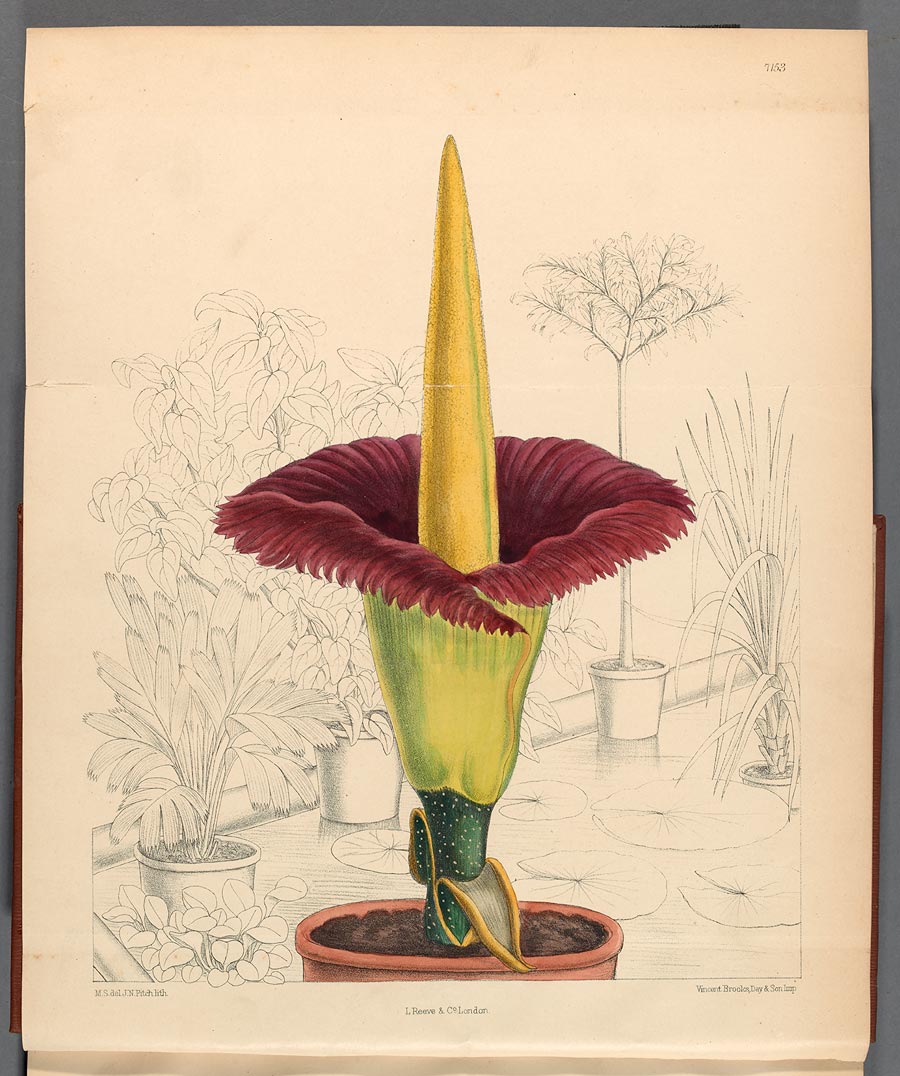
Amorphophallus titanum, hand-colored lithograph by Matilda Smith, Curtis’s Botanical Magazine, 1891. The Huntington Library, Art Museum, and Botanical Gardens. In publication since 1787, Curtis’s Botanical Magazine is the world’s longest-running illustrated botanical and horticultural periodical. Its illustrations until 1948 were hand-colored lithographs. Many of the illustrations, including this work by Smith, are available as custom prints through the Huntington Store.
Sandy Masuo is the senior writer in the Office of Communications and Marketing at The Huntington.